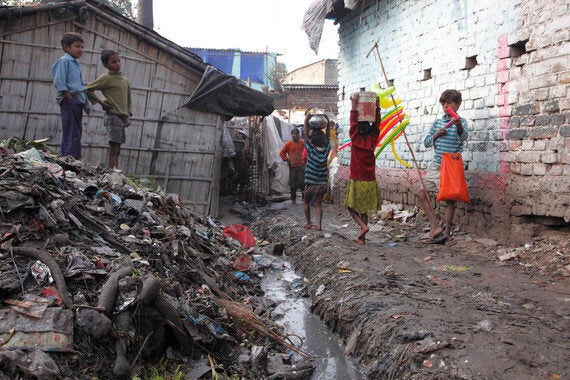India has undergone an astonishing transformation over the past decade or so. When I first visited India in the early 70s few would have predicted that this amazing country would today have an IT industry worth over $100 billion a year or that Indian companies would come to own some of the best known British brands such as Jaguar Land Rover and Tetley Tea.
But this transformation has yet to percolate through to all aspects of Indian life and while the economy races ahead, some areas of social development lag way behind.
One area of particularly stark contrast is access to clean water and safe toilets.
In this sub-continental powerhouse of over 1.2 billion people, almost half relieve themselves outside and nearly one in ten do not have access to clean water.
It is a situation not only blighting India's present but threatening its future.
The cost of poor sanitation
A recent report estimated that the knock-on consequences of inadequate sanitation cost the country around an annual $ 54 billion using 2006 figures - the equivalent of over 6 cents in every dollar earned in India during that year.
The economic impact comes from workers becoming sick, having to take time off to care for family members who are sick, the cost of treating those sick as well as lost tourist earnings.
But over half the total loss calculated was due to people dying prematurely because of disease spread through inadequate sanitation. And nearly four-fifths of the premature mortality economic losses was due to the deaths of children aged under five.
A depressing situation but there is hope in the air that an end to India's sanitation tragedy may just possibly be in sight.

Children carry water by an open sewer in a slum in India. WaterAid/Jon Spaull.
Last year, Prime Minister Narendra Modi launched his high profile Swachh Bharat campaign with the goal of eradicating the practice of people relieving themselves in the open by 2019.
This is an unprecedented opportunity not only to really raise the issue of sanitation and the safe disposal of human waste - a historically unpopular topic - while this is on the political stage but also for all those involved in the campaign to ensure that we work together and learn from our previous experiences, successes and failures.
WASH Summit launches in India
To help bring learning and inspiration together to enhance the campaign, WaterAid India is hosting a three day India WASH Summit from 16-18 February on water, sanitation and hygiene (WASH) in partnership with the Ministry of Drinking Water and Sanitation and Ministry of Urban Development in New Delhi.
It is the first event of its kind, bringing together representatives and thought leaders from the government, non-government organisations and the private sector.
WaterAid is bringing to the table 26 years of experience of working with local partners in India having arrived two years after the government launch of the Central Rural Sanitation Programme.
This was followed in 1999 by the Total Sanitation Campaign and as a result the number of households with access to a toilet rose to one in five which represented significant progress as at the beginning of the eighties coverage in rural areas was as low as one per cent.
What previous sanitation initiatives have taught us is that just building toilets in communities is not enough. Studies from parts of India show that even where toilets exist their usage can be low - and in some places as low as only a third.
Every toilet must be a 'wanted toilet'
So what is absolutely crucial is to ensure that every toilet delivered is a 'wanted toilet'. To stimulate grassroots demand and to help ensure that toilet are used our partners have worked with communities to raise the understanding of the dangers of open defecation and the health benefits to children of good hygiene and sanitation.
The next step is to ensure that the toilet is not only wanted but also cared for. It is no good supporting the construction of toilets which are then abandoned when something goes wrong because no-one in the community has the expertise to fix it - or if it is seen to belong to the organisation that installed it rather than being community owned and their responsibility alongside that of the local government.
WaterAid's experiences and learning from India has helped inform our work much further afield - in other parts of Asia and in Africa - thus helping the poorest and most vulnerable communities across the 26 countries where we work.
Personally, the aspect that has most impressed me over the years we have been working in India, is the power of Indian women's organisations to energise and galvanise communities, in particular, in helping them realise their rights and then vocalise their demands to the local and national authorities.
Their tenacity and commitment has helped transform the lives of many and prevented countless unnecessary child deaths from diarrhoea and other diseases spread by dirty water and poor sanitation.
Women also play a vital role in changing attitudes to sanitation within a community helping everyone understand why it is no longer OK to go to the toilet in the open where others might walk through it.
Armed with the facts, women can work on a community from the inside, persuading, cajoling, educating and sharing in such a powerful way. They can help sow the seeds of behaviour change that can transform a community for generations to come.
By working alongside communities for the long term, WaterAid learns from our experiences and we use that knowledge to improve our work and to share this learning with local organisations and governments.
That is why an event such as this week's WASH Summit is so useful. Colleagues from government, NGOs, development agencies and the private sector will enter the room determined to offer what we can to make a difference. There will be as many questions as answers, but everyone there will bring their own valuable experiences and solutions to the table to contribute together to a sustainable future for India.
This blog was first published on www.trust.org.
